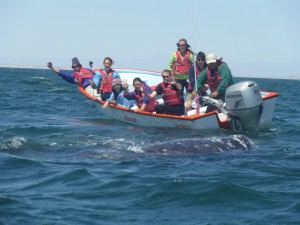Xavier mentioned before we arrived in Baja California our itinerary might change during the trip and flexibility was necessary. While I assumed he meant we needed to take changes to the schedule in stride, I had no idea it would provide our class with an incredible whale-watching opportunity. Due to the high winds on Tuesday our nine hour ferry ride/expedition to Guaymas was delayed so the next morning we drove two hours through the desolate, but striking salt flats surrounding San Ignacio Lagoon. Our destination was Baja Expedition’s whale-watching camp where we hoped to view the gray whales that migrate from Alaska to Baja California to give birth and mate.
We eagerly boarded the boats hoping at the least to spy several gray whales. While I had heard they were curious animals that often approached boats, I can safely say all of my classmates’ expectations of the tour were exceedingly surpassed. Within the first twenty minutes we saw at least ten gray whales and it seemed not a minute went by without someone calling out the location of another whale. This experience alone would have been sufficient; however, Daniel, our captain, assured us the whales would come even closer. Sure enough, although Daniel always stopped the boat a safe distance from the whales, one mom/calf pair purposefully approached our boat rather than continuing on . At this point the boat nearly tipped over as each of us stretched our arms out to feel the indescribable texture of the whales’ skin. As the next hour unfolded, multiple calves swam straight up to the boat, often bumping directly into it, and lingering alongside as we took photos and continued to touch their barnacle-covered heads, while attempting to shield ourselves from their foul-smelling exhalations. Witnessing these giant creatures behave so curiously was an experience I will never forget, but during the tour one thought nagged at me I knew I would have to reflect on later.

Because of my interest in marine mammal conservation I am aware of the harmful effects tourism can have on these animals’ populations. My master’s project focused on reducing dolphin harassment as a result of tourism, specifically in Florida and Hawaii. I also recently returned from a research trip in Hawaii where we witnessed up to 100 swimmers in the water with one group of spinner dolphins attempting to rest from their prior nighttime foraging activity.
Given my knowledge about these issues, as we (myself included) eagerly leaned over the boat to touch these whales, I could not help but wonder if our actions constituted harassment as defined by U.S. legislation. The Marine Mammal Protection Act defines “harassment” as any act of pursuit, torment, or annoyance which—
(i) has the potential to injure a marine mammal or marine mammal stock in the wild; or
(ii) has the potential to disturb a marine mammal or marine mammal stock in the wild by causing disruption of behavioral patterns, including, but not limited to, migration, breathing, nursing, breeding, feeding, or sheltering.
To the outside observer one would assume our close interactions with these gray whales would disturb their natural behavioral patterns. However, from the research I gathered, little evidence exists these tourist ventures negatively affect gray whales. Now that I have been on the tour I understand this lack of evidence because I witnessed the whales purposefully seeking out human interaction.

While I was initially dubious about this tourist venture, I learned the Mexican government has taken great strides to protect its whale populations. In 1971 the government established the first ever whale refuge in Laguna de Ojo Liebre which was expanded to include San Ignacio in 1979. In 1988 the government created the Vizcaíno Biosphere Reserve which spans from San Ignacio to Laguna de Ojo Liebre and is the largest protected area within Mexico. The establishment of the reserve allowed for stricter regulation of the whale watching tourism activity. In terms of legislation, the Official Mexican Standards (“NOMs”) established a permitting system limiting the number of companies involved in gray whale watching and implemented regulations for responsible practices including maximum boat speeds, limitation on number of boats on the water, and designated areas for whale watching. Conservation measures have also been taken at the community level; for example, the permitted companies in San Ignacio Lagoon have created specific rules to protect the whales including limiting the number of boats and time spent with one specific whale and maintaining a 20 yard distance from the whale unless it approaches the boat. The community members we spoke to explained these self-imposed regulations were not created to benefit the tourism industry, but instead to conserve the gray whale populations.
Although my previous research taught me to be skeptical of these human-marine mammal interactions and prompted me to think critically about this whale watching expedition, I learned from this experience that one needs to gather more information in order to have a complete picture before making snap judgment calls. Things are not always as they appear.
